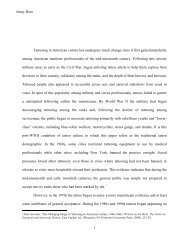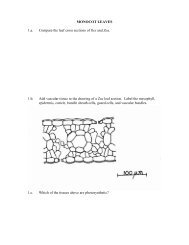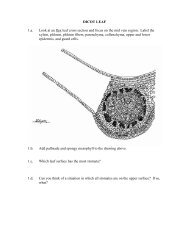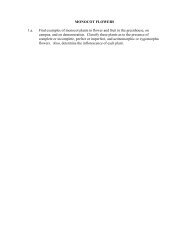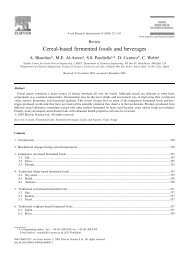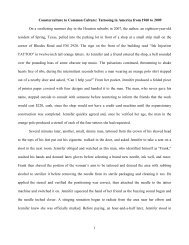John WibberleyProducersRural livelihoods depend on a Highway Code for trade<strong>Meat</strong>: <strong>the</strong> challengeInternationally, livestock integrated withinfarm-household systems and landscapesprovide huge benefits. By-products ofmanure/urine become crop inputs enrichingsoils and composts, and potentially generatingbiogas and natural pesticides. Hides, skins,horns, wool and fea<strong>the</strong>rs sustain craft andutilitarian businesses. Livestock provideentrepreneurial farmers everywhere withvaluable assets. They store wealth capable ofnatural capital increase and regular cash-flowgeneration with good management. They canutilise o<strong>the</strong>rwise wasted crop by-productsas feedstuffs or bedding. Extensively grazedanimals maintain landscapes and countrysidebeauty required by civil society and tourism.Milk, meat and eggs greatly enrich humandiets when taken in moderation, though <strong>the</strong>ycan cause obesity and associated diseaseswhen consumed to excess (also losing foodconversion efficiency compared to directvegetable consumption).In short, properly integrated livestockimprove <strong>the</strong> energy-efficiency of farmingsystems, <strong>the</strong> quality of human diets,environmental management, <strong>the</strong> livelihoodsof rural communities and <strong>the</strong> health of urbanpopulations. By contrast, <strong>the</strong> trend towardslarge-scale, intensive livestock offers some‘economies of scale’ to a point beyond whichcheapness threatens animal welfare, diseaseproliferation (e.g. bird ’flu), environmentalpollution (when manures and effluentsbecome a cumulative problem ra<strong>the</strong>r than astrategic resource), livelihood risk, food safetyand public health, and generates bureaucracyto seek to avert all <strong>the</strong>se. The consequentstress on farmers is coupled with a drop in <strong>the</strong>overall energy-efficiency of farming systemswith leng<strong>the</strong>ned food chains. Moderatescale family farming aggregates production,protection and societal benefits.Currently, many livestock farmers worldwideface huge livelihood challenges characterisedby cost/price squeezes which produce lowermargins per animal sold and ratchet up <strong>the</strong>trend to keep more animals per farm in orderto try to compensate. Many livestock farmershave left, except where tiny numbers oflivestock are involved on a truly subsistencebasis such that <strong>the</strong>ir products scarcely enter<strong>the</strong> market system and feed inputs are largelyhome-grown.This polarisation between tiny and hugelivestock units most heavily eliminatesmedium-sized enterprises (arguably thosemost capable of giving <strong>the</strong> best aggregatebenefits). Food chains leng<strong>the</strong>n as distancesincrease between concentrations of animalsand concentrations of <strong>the</strong> consuming public,with additional transport and animal welfareimplications. All this means extra costand bureaucracy for EU farmers with tightregulation to minimise animal sufferingduring production, restricted journey timesfor live animals in transit, improved animalcomfort, a ban on <strong>the</strong> burial of fallen stockand close monitoring of all this by vets andhealth inspectors. Corresponding legislationto require <strong>the</strong> upgrading of silage clamps ando<strong>the</strong>r buildings, while suiting good farmers’aspirations, is often introduced so quicklythat <strong>the</strong>y cannot afford to implement itand thus ano<strong>the</strong>r farm is lost. Concentratedrisks, as recently seen in <strong>the</strong> UK, can leadto shutting down large areas of <strong>the</strong> countryfollowing disease outbreaks like foot andmouth, and bluetongue; meanwhile, greaterselective control approaches to alreadyendemic diseases such as tuberculosis haveso far been denied.Dumping chicken bodyparts unwanted byWestern markets displacesmany small farmersThe pressure for unregulated trading comingthrough <strong>the</strong> WTO is leading to <strong>the</strong> leastcostproduction of livestock, with immenseethical and practical problems. Countriesbest equipped to produce cheaply, owing tolow labour costs combined with adequateinfrastructure and logistics, are able to flooddistant markets with animal products whichhave become commoditised. Production,transport, food safety and o<strong>the</strong>r standardsassociated with many of <strong>the</strong>se systems fallshort of those set for EU farmers to <strong>the</strong>considerable extra cost of <strong>the</strong> latter. Both<strong>the</strong> poorest tropical farmers and manywelfare-compliant EU farmers are penalisedby this far from level playing field. In WestAfrica, cheap chicken arrives from afar tosell at prices half that required to cover <strong>the</strong>costs of small-scale, private-enterprise,home-produced poultry, thus destroyingfarm livelihoods. In <strong>the</strong> poorest nations,dumping chicken body parts unwanted byWestern markets (all but breasts and legs)displaces many small farmers. Fur<strong>the</strong>rmore,<strong>the</strong> industrialisation and commoditisationof animal production leads to huge wastageunbelievable to small-scale mixed farmersin Africa – such as <strong>the</strong> frequent killing ofsurplus young males. A third of <strong>the</strong> food webuy in <strong>the</strong> UK ends up being thrown away.Dairy farms are in particular crisis: in <strong>the</strong>Isle of Wight fewer than 20 percent of <strong>the</strong>dairy farms existing a decade ago are stilloperating; in Iowa, USA, 5,000-cow herdsare common. Yet Send a Cow has recentlydone studies showing huge positive impactsof a single cow on farm-household systemvitality and viability in Uganda – and, in suchintegrated systems, <strong>the</strong> carbon-footprint(notably methane and manure) is offset byrecycling, by fodder and tree planting suchthat over 5 years it is 2.5 times positive!A long-term vision for agriculture requiresa Highway Code for agricultural tradegovernance. This would consist of minimalbut relevant national and internationalregulation to aggregate benefits and avertthreats, delivering:Conserved, biodiverse landscapesproducing food, with farmers ‘<strong>the</strong>re to care’for land;Vibrant rural economies adding value tofood and non-food farm products;Networks of equitable, relationalcommunities.Professor John Wibberley isan agriculturalist and resourcemanagement consultant. Heis Visiting Professor at <strong>the</strong>Royal Agricultural Collegeand serves in RURCON, ano<strong>the</strong>rwise all-African teamof Christian Developmentleaders and practitioners insub-Saharan Africajohn@wibbs.fsnet.co.uk.06 Winter 2007 | Volume 2 Issue 4 | www.foodethicscouncil.org
<strong>Meat</strong>: <strong>the</strong> challengeAnimalsGood animal welfare must be our starting pointRuth LaytonA wise colleague once pointed out that“poverty is sustainable”. So is poor animalwelfare. As sustainability storms up <strong>the</strong>policy agenda, animals are all too often lefton <strong>the</strong> margins.Our job at <strong>the</strong> Food Animal Initiative(FAI) is to design, implement and promotesustainable food production systems basedon good animal welfare. We talk about <strong>the</strong>‘three Es’ for sustainable food productionsystems: <strong>the</strong>y should be Ethical, look after<strong>the</strong> Environment and be Economicallyviable. By ethical we (and <strong>the</strong> Oxford EnglishDictionary) mean doing <strong>the</strong> right thing, andthat means <strong>the</strong> right thing for animals aswell as for people.This is no mean task, so let’s put it inperspective. In 2006, world-wide, 24million pigs, 884 million poultry, six millioncattle and 17 million sheep and goats wereslaughtered for human consumption – everyweek. That amounts to an annual globalmeat production of 276 million tonnes. Thisis expected to rise to 465 million tonnes by2050.Poverty is sustainable. Sois poor animal welfareGlobally, eight percent of meat productionis from grassland-based systems of beef andsheep (ruminants), compared to 46 percentfrom <strong>the</strong> landless or intensive productionof pigs and poultry. To cope with increaseddemand for meat and o<strong>the</strong>r livestockproducts, livestock production is rapidlyshifting from grassland-based systemstowards more intensive landless productionof pigs and poultry. Over <strong>the</strong> decade to2001/3, pig meat output rose by 30 percentat world level, with <strong>the</strong> increase accounted foralmost entirely by Asia. The total productionof poultry meat grew by around 75 percent,again with <strong>the</strong> greatest expansion in Asia.In contrast, over <strong>the</strong> same period, ruminantproduction rose by 12.5 percent. This shifttowards landless production is contrary towhat FAI views as <strong>the</strong> most sustainable wayforward for food production, which is a moveto mixed agriculture that allows animal andcrop production to benefit from each o<strong>the</strong>r.Our approach is based on understanding<strong>the</strong> animal first and designing <strong>the</strong> systemaround this knowledge. We championanimals because <strong>the</strong>ir voice, though wellheardthrough animal welfare organisations,cannot be acted upon unless alternative highwelfare systems are provided and promoted.We encourage farmers, industry partnersand NGOs to understand what we call <strong>the</strong>‘sustainable potential’ of a system and toput <strong>the</strong>ir energy into developing systemswhich have good sustainable potential asthis makes business sense in <strong>the</strong> long term.This concept of sustainable potential is oftendifficult to embrace for large producerswhose livelihoods have evolved aroundsystems which have no sustainable potentialbut which are enjoying considerable currentsuccess.A system with sustainable potential hasto take care of people, animals and <strong>the</strong>environment whilst being economicallyviable. So, in animal welfare terms, suchsystems as <strong>the</strong> conventional battery cage or<strong>the</strong> farrowing crate are not an option. Scienceprovides us with overwhelming evidence that<strong>the</strong>se systems do not and will not provide for<strong>the</strong> needs of <strong>the</strong> animals involved. Although<strong>the</strong> major food buyers are increasingly awareof this evidence, <strong>the</strong> major driver for <strong>the</strong>move away from systems such as ‘crates andcages’ is that a significant proportion of <strong>the</strong>ircustomers tell <strong>the</strong>m <strong>the</strong>y do not want foodfrom <strong>the</strong>se systems.There are increasing examples of producersmoving to systems with better welfarepotential, such as free range eggs and porkproduced from outdoor systems (whichdo not use farrowing crates), and <strong>the</strong>re isa growing demand for pork from pigs thathave not had <strong>the</strong>ir tails docked.If we measure some of <strong>the</strong> high animalwelfare-potential systems – free rangeegg production being a good example – interms of a specific welfare outcome such asmortality, <strong>the</strong> system would often compareless favourably than a cage system. However,with scientific knowledge and best practicehusbandry techniques, we can reach<strong>the</strong> full high animal welfare-potential ofsystems such as free range. By contrast, <strong>the</strong>confinement of a conventional cage meansthat birds will never be able to move about,investigate <strong>the</strong>ir environment and engage inactivities important to <strong>the</strong>m.Once producers move tohigh-welfare systems <strong>the</strong>ydon’t want to turn backThe burning question is whe<strong>the</strong>r highanimal welfare-potential systems also havesustainable potential in terms of economics,people and <strong>the</strong> environment? The shortanswer is that <strong>the</strong> proof of systems likefree range lies in <strong>the</strong>ir growing marketshare. Anecdotal evidence tells us that onceproducers make <strong>the</strong> move to <strong>the</strong>se systems,<strong>the</strong>y don’t want to turn back – <strong>the</strong> food<strong>the</strong>y produce is as safe and often bettereating quality. The environmental debate, ofcourse, rages. Our work at FAI shows thatsuch systems are <strong>the</strong> most environmentallysustainable as <strong>the</strong>y have <strong>the</strong> potential to beintegrated into mixed agricultural systemswhere animals and crops are grown side byside for <strong>the</strong> benefit of all.Ruth Layton is a veterinarysurgeon. She is a founder andDirector of <strong>the</strong> Food AnimalInitiative and currently sits on <strong>the</strong>Farm Animal Welfare Council,which advises governmenton matters relating toanimal welfareruth.layton@faifarms.co.ukwww.foodethicscouncil.org | Volume 2 Issue 4 | Winter 2007 07




